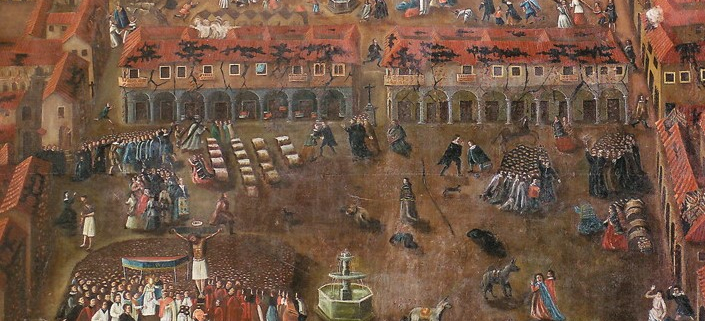The monographic issue Desastres en la América hispánica: circulación de noticias y saberes (siglos XVI-XVIII) has been published in the open access journal Nuevo Mundo. Mundos Nuevos. The studies collected in the dossier are the result of reflections that emerged during the seminar Disasters in Hispanic colonial America: networks, memory and the circulation of knowledge organized on 13th September 2021 at the University Pablo de Olavide in Seville, as part of the activities of the research projects DisComPoSE, directed by Domenico Cecere, and Rexpublica, directed by Manuel Herrero Sánchez.
This publication, exploring natural calamities in Hispanic America in the sixteenth, seventeenth and eighteenth centuries, aims to bridge the gap between cultural, political-institutional, social and environmental research realized in the field of disaster studies. The case studies presented have highlighted the importance of the Atlantic territories in terms of the circulation of news through different networks and the development of knowledge during emergency situations.
The authors, although they approach these events from different methodological points of view, agree in identifying three main aspects of disaster analysis: the networks in which the processes of the transfer of news about disasters take place and the phenomena of the creation and circulation of knowledge.
Natural events with catastrophic consequences have, in fact, an immense potential to generate intense flows of information and to encourage social interactions aimed at sharing news and experiences in order to overcome or understand the trauma experienced. The articles by Varriale and Orozco Cruz deal with the analysis of the transfer of information in times of emergency through various channels (viceroys, diplomats, councils, nobility and their correspondents, merchants and cities). The topoi circulated as an interpretation of the catastrophe in printed texts and manuscripts of early modern times are, instead, one of the subjects of the contributions by Ben Yessef Garfia and Petit-Breuilh Sepúlveda.
The dossier highlights the capacity of natural threats with disastrous effects to act as an open window on the American societies concerned, since these events allow us to assess the vulnerabilities and ways of thinking of the actors involved, the relations between different institutions and the connections between disasters and pre-existing social, political and economic problems.
In addition, the study reports the mechanisms put in place by the various institutions and individuals to maintain control or to conquer new spheres of power after a calamity, stressing the importance of the phenomena of post-disaster political communication and the plurality of the institutions and the social partners involved in their definition.
The conflict between the different points of view was, for example, the direct consequence of a greater participation of the authorities in emergency management and one of the factors that led to the development of a new narrative of disaster.
Desastres en la América hispánica: circulación de saberes y noticias (siglos XVI-XVIII)
Coord. Yasmina R. Ben Yessef Garfia
- Yasmina Rocío Ben Yessef Garfia
The pontifical and royal dos cuchillos: a difficult balance in times of calamity in viceregal Peru (second half of the Seventeenth century)
- Gennaro Varriale
From the official letters to the rumor. The communication on the earthquakes in the Hispanic Monarchy (17th Century)
- Jonatán Orozco Cruz
Information networks and business opportunities after the Lima earthquake of 1687. Accounts of the management of the catastrophe through the agents of the Asiento Slave Trade
- María Eugenia Petit-Breuilh Sepúlveda
About the origin of earthquakes and tsunamis in the mid-eighteenth century: Circulation of ideas between the territories of Spanish America and the metropolis






Leave a Reply
Want to join the discussion?Feel free to contribute!